
|
|
Für die deutsche Fassung bitte nach unten scrollen
|
|
"The Work which is to be Done" –
The Major Summer Exhibition
|
|
|
Dear friends of ancient art, the good news right away: From now on our two galleries in Vienna are open again as usual. Visit us in our showroom and look forward to numerous newly acquired ancient artworks, including important marble sculptures, such as the portrait of Empress Agrippina Minor, Egyptian treasures, such as the faience shabti of Tjanehebu, as well as an almost perfectly preserved Macedonian cavalry helmet. Antiquities in all price ranges await you and will certainly delight you. Our small gallery in Stubenring has recently been renovated and converted into a precious showcase, I am looking forward to also welcoming you there for a glass of wine.
|
The major summer exhibition starting June 9. More than that we have a lot of plans for the upcoming weeks: From 9 June we will present together with the Austrian artist and STRABAG Artaward winner Philip Patkowitsch the exhibition "the work that has to be done" in our showroom. Based on our extensive collection of faience shabtis, the artist has transformed each of the 230 figures into an ink drawing. These represent the interplay between the representational and the abstract, between archaeological drawings and the free play with light and shadow. Here is a preview how this looks like. The exhibition can be visited during our opening hours or upon request.
|
|
|
|
|
|
Our Highlight of the Month:
|

|
|
|
|
|
|
Roman Empire – 1st century A.D.
|
Life-size portrait of the empress Agrippina Minor, Claudius' wife and Nero's mother. The face with straight, fine features, a thin long nose, and eyes which look gently and gracefully out of thick lids. The mouth well-formed and closed. Her hair is parted in the middle, on the head wavy and running down in thick small curls framing the face. Agrippina Minor, who was also great-granddaughter of Augustus, took over this striking hairstyle from her mother Agrippina Maior. She thereby also alludes to her noble decent from the gens Iulia. The head is slightly bent to the left, therefore the Venus rings build up on the left side of the thin neck. The slightly coarse marble as well as the compact, slightly motionless form indicate the production in the Eastern Mediterranean region. The bigger the distance to the capital Rome the more Agrippina Minor appears as the second Agrippina Maior. The large popularity of the parents Germanicus and Agrippina Maior lies behind this effect. The head is multiple-times published: H. Jucker and D. Willers, „Gesichter: Griechische und römische Bildnesse aus Schweizer Besitz“, Bern 1982, pages 96-97, number 38. Ines Jucker, „Skulpturen der Antiken-Sammlung Ennetwies“, Mainz am Rhein 1995, volume I, pages 37-38, number 20. In this publication Ines Jucker assumes that this is not Agrippina Minor, but a private portrait closely relating to the empress. Arachne database number 1082668.
|
Provenance: Private collection Dr. Anton Pestalozzi (1915-2007), acquired 1977 from La Reine Margot in Paris. Exhibited in the Bernese History Museum, „Gesichter: Griechische und römische Bildnisse aus Schweizer Besitz“, from 6 November 1982 to 6 February 1983.
Dimensions: 28cm high
Price: 68 000 Euro
|
|
|
|
Selected Artworks of the Month:
|
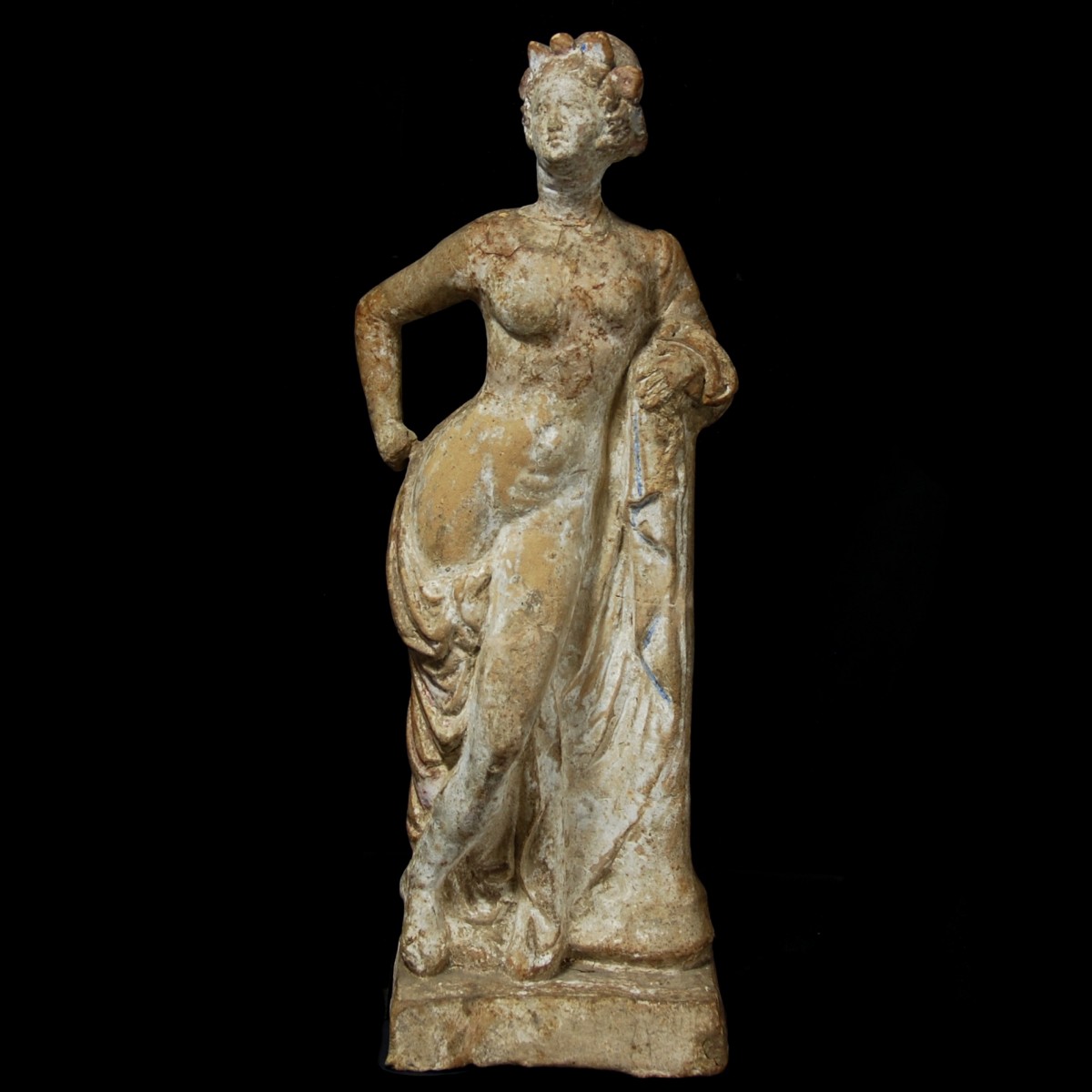
|
|
|
|
|
|
Greece/Myrina – 2nd century B.C.
|
Magnificent terracotta statuette of Aphrodite standing on a rectangular plinth. The goddess rests with the weight on the right leg against a pillar. The left leg crossed zestfully around the supporting leg. Aphrodite is undressed, she is holding with the left supported hand a mantle, which falls over the back of the hips and folds down between the legs. The right arm is placed on the pelvis turned cheekily outwards. She wears a floral diadem on her head, her hair is pulled back to a round bun. With abundant color remains. Possibly from Myrina. An old collection sticker at the bottom.
|
Provenance: French private collection Charles-Louis Frossard (1827-1902). Through inheritance to daughter Emilie Isabelle Frossard (1854-1921). Thence through inheritance to Henry Schloesing (1879-1958) who sold it in 1928 to Joseph Altounian (1890-1954). Since then in a family estate. Accompanied by a copy of an old collection photograph from the Frossard estate and a French antiquities passport.
Dimensions: 27.7 cm high
Price: 6 800 Euro
|
|
|
|
|
|
|
|
|
|
|
Iran/Luristan – End of 2nd millennium B.C.
|
Solid and very long bronze sword worked out of two pieces. The hilt with a rectangular profile tapering off to crescent-shaped horn, which overlap the blade. The ear-shaped, hollow pommel on the sides with tilting fans, namesaking the sword. The pointed blade with a curved middle ridge.
|
Provenance: Old Belgian private collection. Thence with André Munter Archeologie, Brussels, Belgium. There acquired on 11 March 2002 by another Belgian private collection. Accompanied by a certificate from André De Munter, Brussels, Belgium. On the back of the certificate a sticker with a stamp of a court inspcetion dated 26 Jun 2009 with the signature of the law clerk F. Coene N.
Dimensions: 69 cm long
Price: 4 000 Euro
|
|
|
|
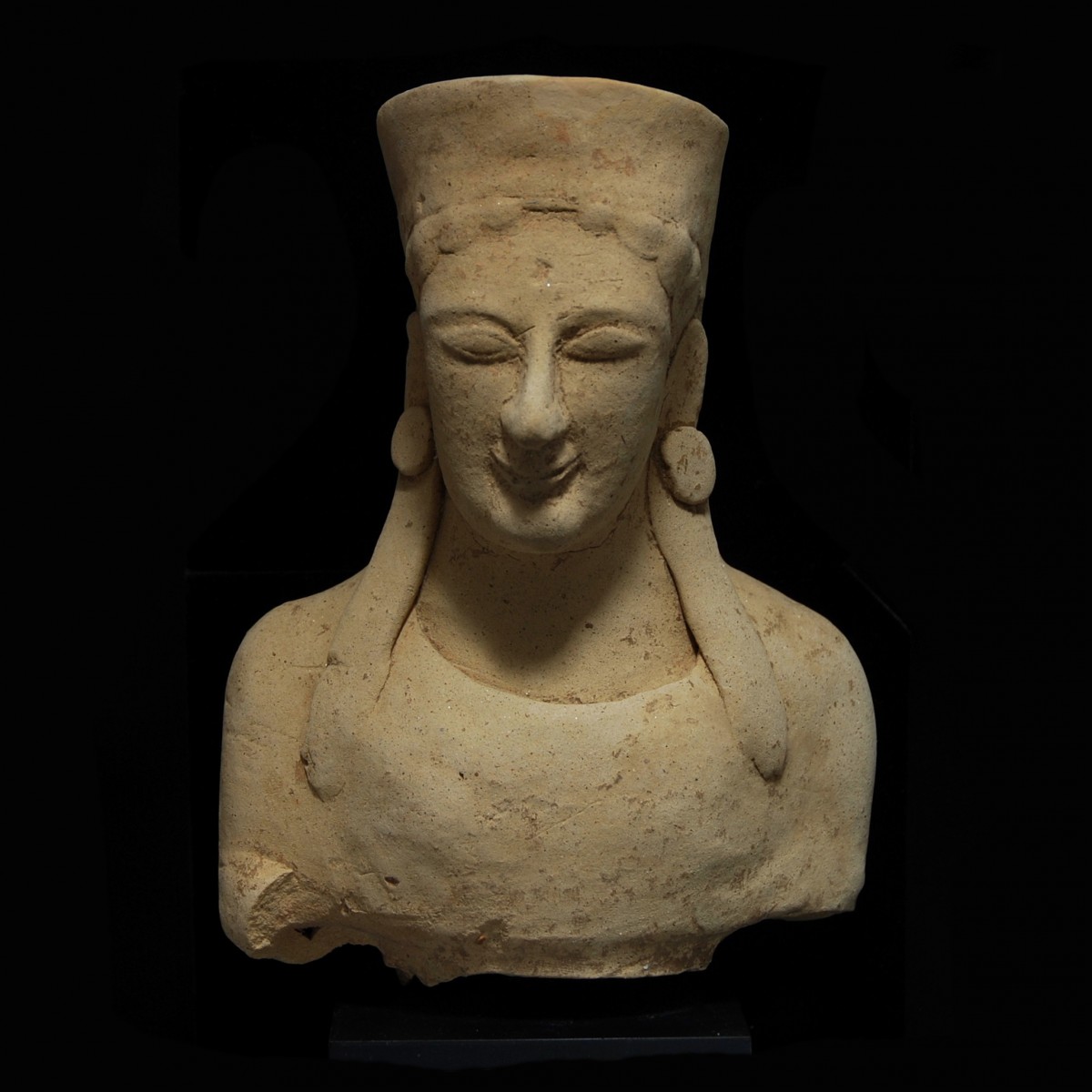
|
|
|
|
|
Expressive terracotta bust of a goddess dating to the archaic period. The statuette fragment, hollow inside, with an oval face, the typical smile and almond-shaped eyes. The goddess wears a high polos with short curls looking out, framing the face. Two long strands fall on the sides over the shoulders and reaching to the chest. The ears are decorated with large, disk-shaped earrings. Face and body are formed from a mold, some details, such as the strands and ear jewelry, formed by hand. Mounted.
|
Provenance: Swiss private collection Zakos, 1980s. Thence in a US collection in New York.
Dimensions: 19,5 cm high
Price: 4 800 Euro
|
|
|
|
|
|
|
|
|
|
|
Egypt – 26th dynasty, Reign of Amasis II, 570-526 B.C.
|
Shabti of green glazed faience originating from Tjanehebu’s tomb. The mummiform figure with a tripartite wig, false beard, back pillar and crossed arms in front of the chest. The shabti holding an adze and a hoe, the seed basket hangs over the left shoulder. The inscription in eleven lines mentions Tjanehebu as the owner, the overseer of the royal ships, son to Tanefretiyti. The translation reads: "The Illuminated One, the Osiris, the Overseer of the Royal Ships, Tjanehebu, born to Tanefretiyti, he speaks: O, these shabtis, if one counts off the Osiris, the Overseer of the Royal Ships, Tjanehebu, justified, to do every work which is done there in the necropolis – now indeed obstacles are implanted there – as a man at his duties. “Here I am”, you shall say, when you are counted off at any time to serve there, to cultivate a field, to irrigate the shores, to transport by boat the sand of the West to the East and vice versa. “Here I am”, you shall say.” Tjanehebu’s tomb was excavated by the Italian Egyptologist Alessandro Barsanti in 1900 south of the Pyramid of Unas in Saqqara. The excavated shabtis were sold around the world – see for reference the example in the British Museum with the registration number 1901,0311.16. Mounted.
|
Provenance: German private collection since 1970.
Dimensions: 18.6 cm high
Price: 6 800 Euro
|
|
|
|
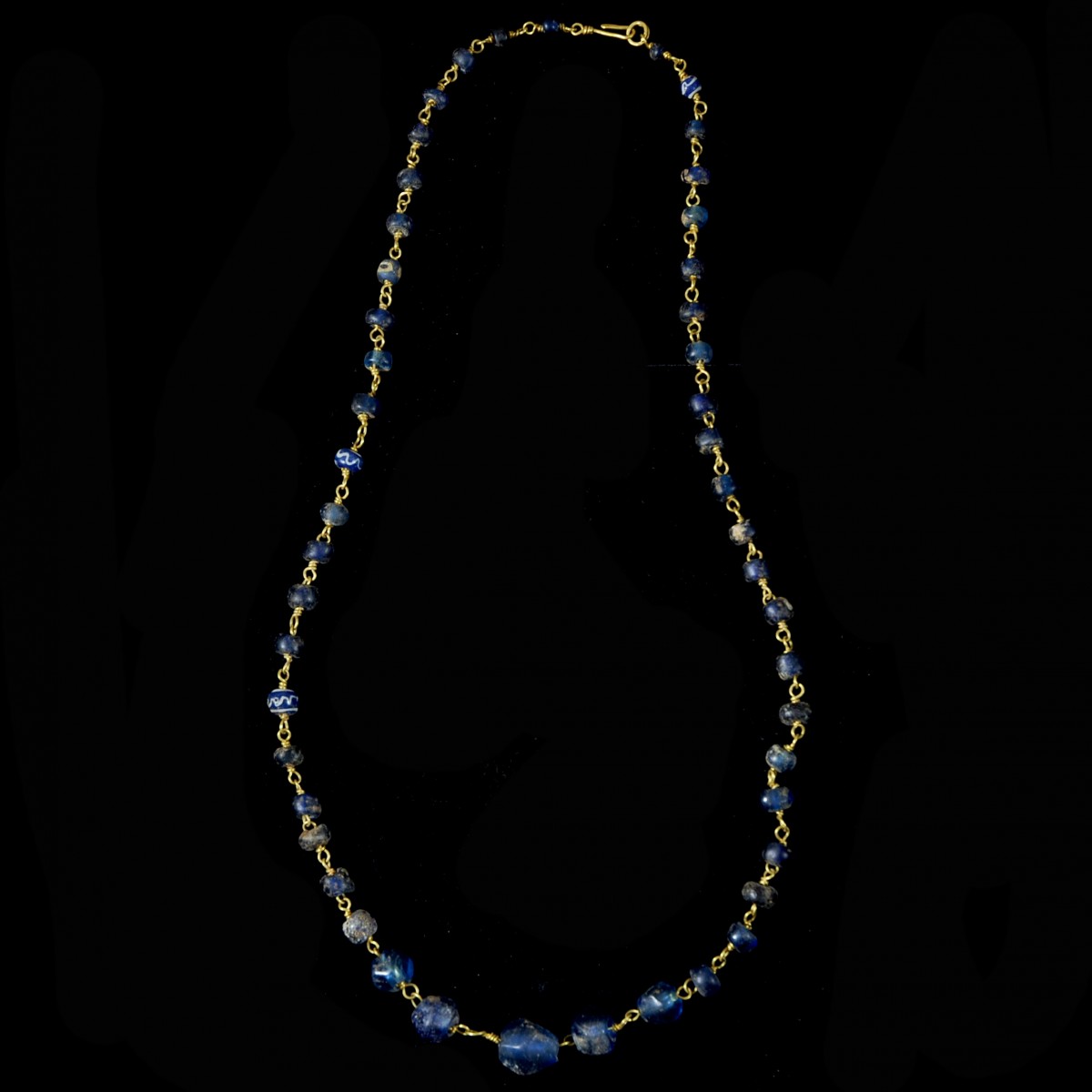
|
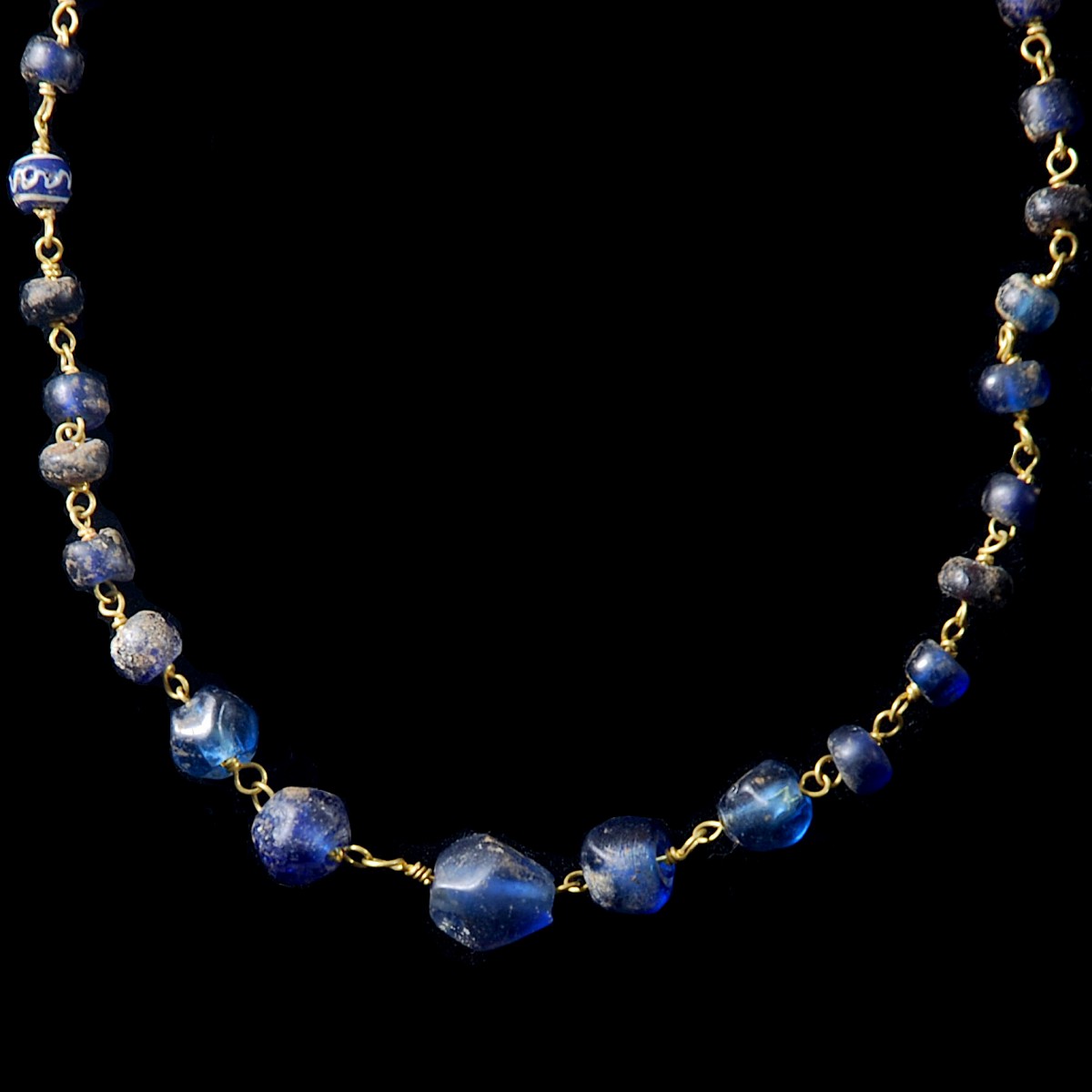
|
|
|
|
Roman Empire – 2nd-3rd century A.D.
|
Ready to wear gold necklace with blue glass beads in different sizes. The finale is formed by large glass beads with finely cut edges. Four beads are of blue and white glass. The chain links of gold wire are probably from the early 20th century.
|
Provenance: German private collection H.-D. D., North Rhine-Westphalia. Acquired between 1975 and 1998.
Dimensions: 58 cm long
Price: 1 600 Euro
|
|
|
|
|
|
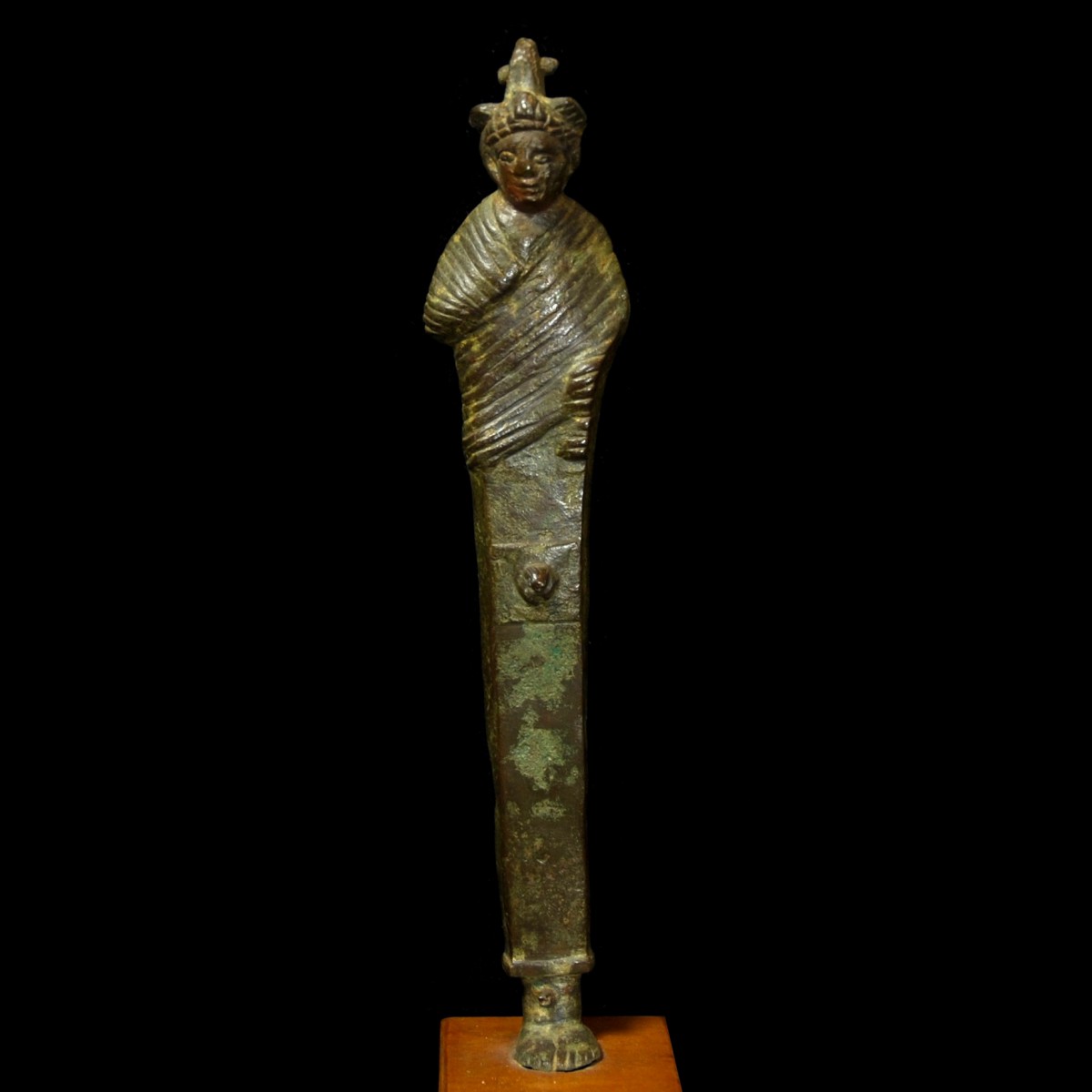
|

|
|
Roman Empire/Gaul – 2nd century A.D.
|
Large bronze applique in form of a herm with the head of Mercury (Hermes). The face framed by thick curls, where the god's wings are mounted. The upper body wrapped in a cape with delicate pleats, which the god presses to his chest. The pier shaft in the centre with the typical phallus, which stands out from a raised band. At the lower end of the shaft a circular basis, where toes are incised. Rare, very fine depiction of a bronze herm which possibly once decorated a furniture. On an old wood base.
|
Provenance: Old French private collection.
Dimensions: 20.5 cm high
Price: 3 800 Euro
|
|
|
|
|
|
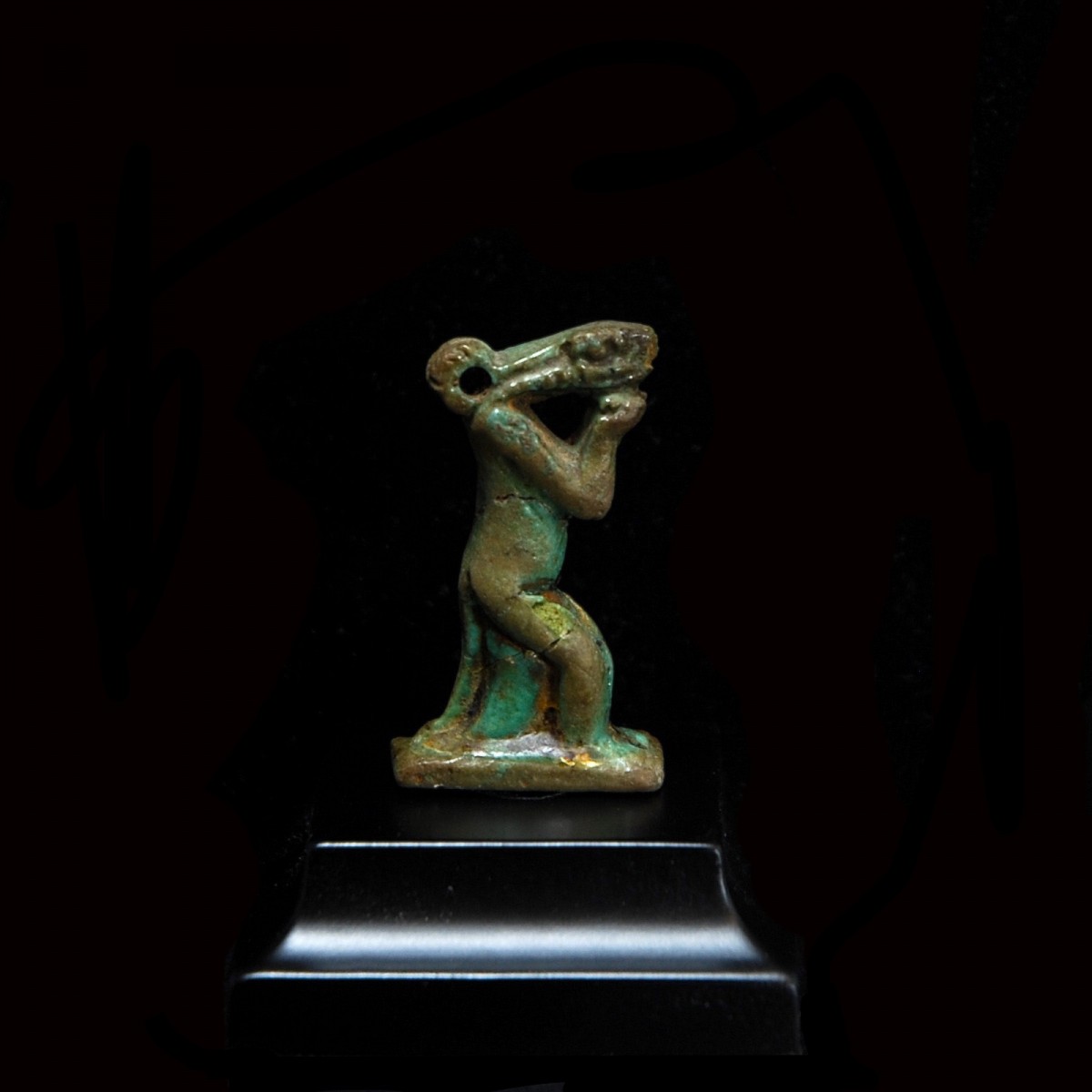
|
|
Egypt – 3rd Intermediate Period, 1070-664 B.C.
|
Faience amulet worked out in high quality of the god Nehebkau, the guardian of the entrance to the otherworld, and one of the 42 judges of the dead. Nehebkau is depicted seated, his arms placed under the large snake head. At the back of the head an eyelet for suspension. Mounted.
|
Provenance: French private collection Bourgade-Maturana, acquired on 7 June 1977 from Laurin Guilloux Buffetaud Tailleur in Paris. Accompanied by a copy of the original invoice and the French antiquities passport.
Dimensions: 3.8 cm high
Price: 1 600 Euro
|
|
|
|
|
|
|
|
|
Roman Empire – 2nd century A.D.
|
Roman gold ring with a hoop of gold sheet, broadening towards the bezel. The setting, also of gold sheet, holds a longitudinally ovale, multilayered tricolor agate. Ready to wear.
|
Provenance: Collection Maurice Bovier (1901-1981), Switzerland.
Dimensions: 2.1 cm high; 2.1 cm in diameter (ring); 2.7 gram
Price: 600 Euro
|
|
|
|
|
|
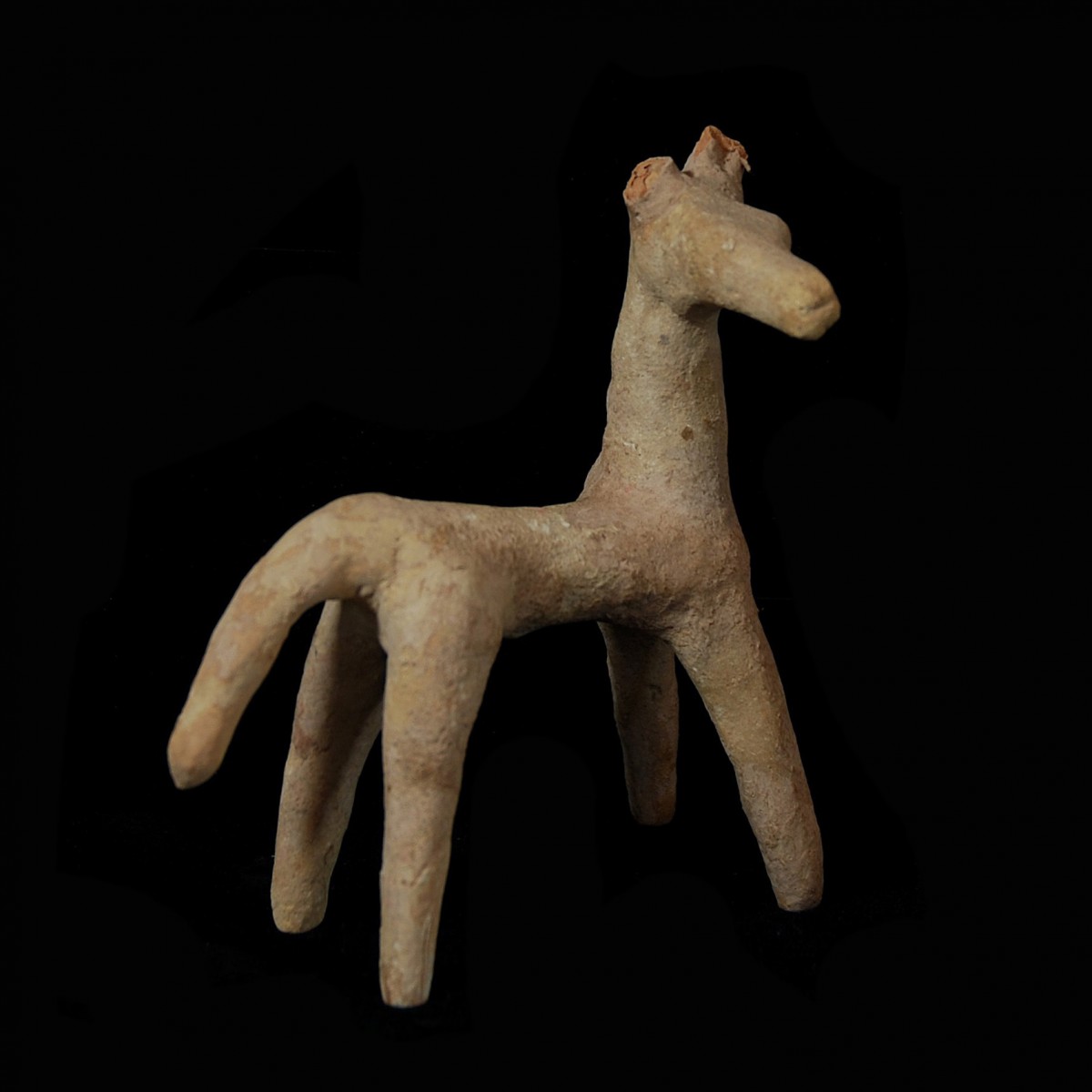
|
|
Greece/Boeotia – 6th century B.C.
|
Hand-formed terracotta statuette of a horse. The body slender with four straight legs. The tail long and slightly protruding, the head with raised ears turned to the side. The eyes indicated by round indentations.
|
Provenance: Charles Ede London 1978, thence collection Dr Anton Pestalozzi (1915-2007), Zurich, Switzerland.
Dimensions: 12.8 cm high
Price: 600 Euro
|
|
|
|
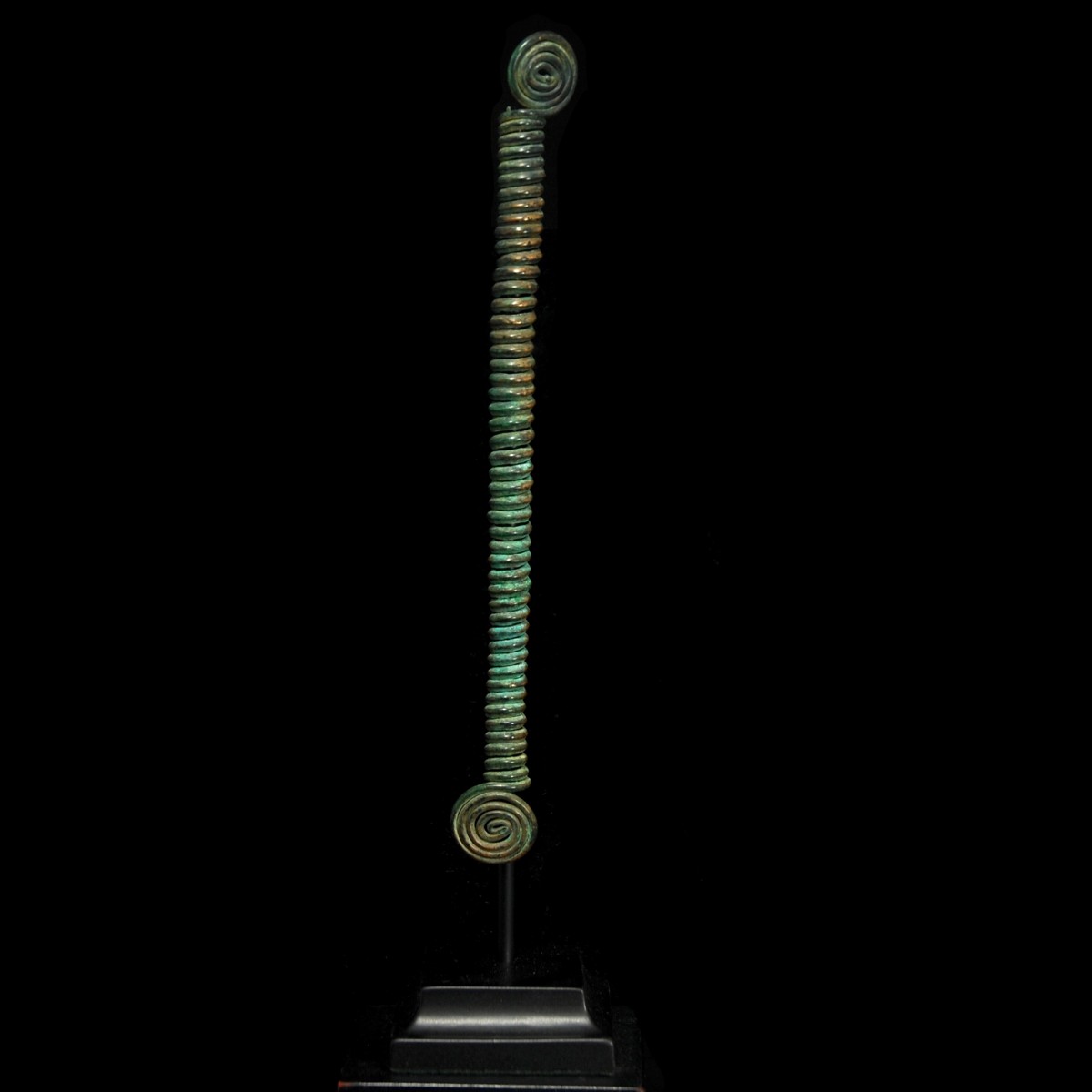
|
|
|
|
Middle Europe – 11th-10th century B.C.
|
Elongated spiral tube consisting of a massive bronze wire with a raised midridge. On each end of the tube a finely twirled end spiral. Spiral tubes like the present one were part of the Central European ritual costume of the Urnfield Period. Mounted.
|
Provenance: Private collection Hagenauer, Vienna
Dimensions: 16.4 cm long
Price: 380 Euro
|
|
|
|
|
|
A Collection of Stone Age Hand Axes from the Estate of Wilfriede and Leopold Tamm, Langenzersdorf, Austria.
Acquired in the 1970s:
|

|
|
North Africa/Libya – 400,000-50,000 B.C.
|
|
Small quartzite stone tool worked out on both sides with sharp-edged ribs on the sides to cut plants and meat. Wonderful texture. Found in Libya.
|
Dimensions: 7 cm x 4.8 cm
Price: 200 Euro
|
|
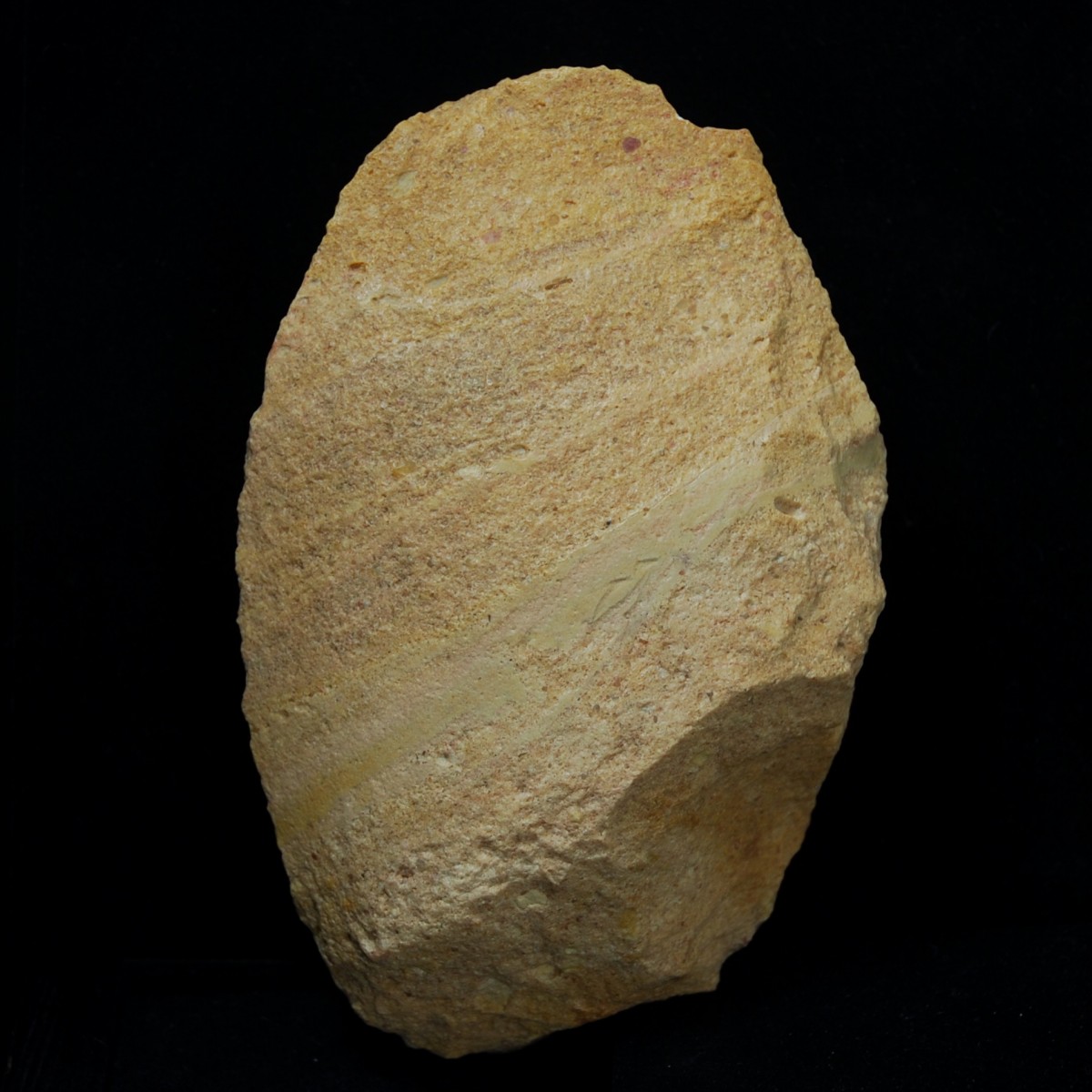
|
|
North Africa/Libya – 800,000-300,000 B.C.
|
|
Massive and heavy hand axe of light quartzite worked out on both sides. The edges are all sharpened to cut plants or meat. The tapering end was used as a drill. With a beautiful desert patina. Found in Libya.
|
Dimensions: 15.5 cm x 9.5 cm
Price: 200 Euro
|
|
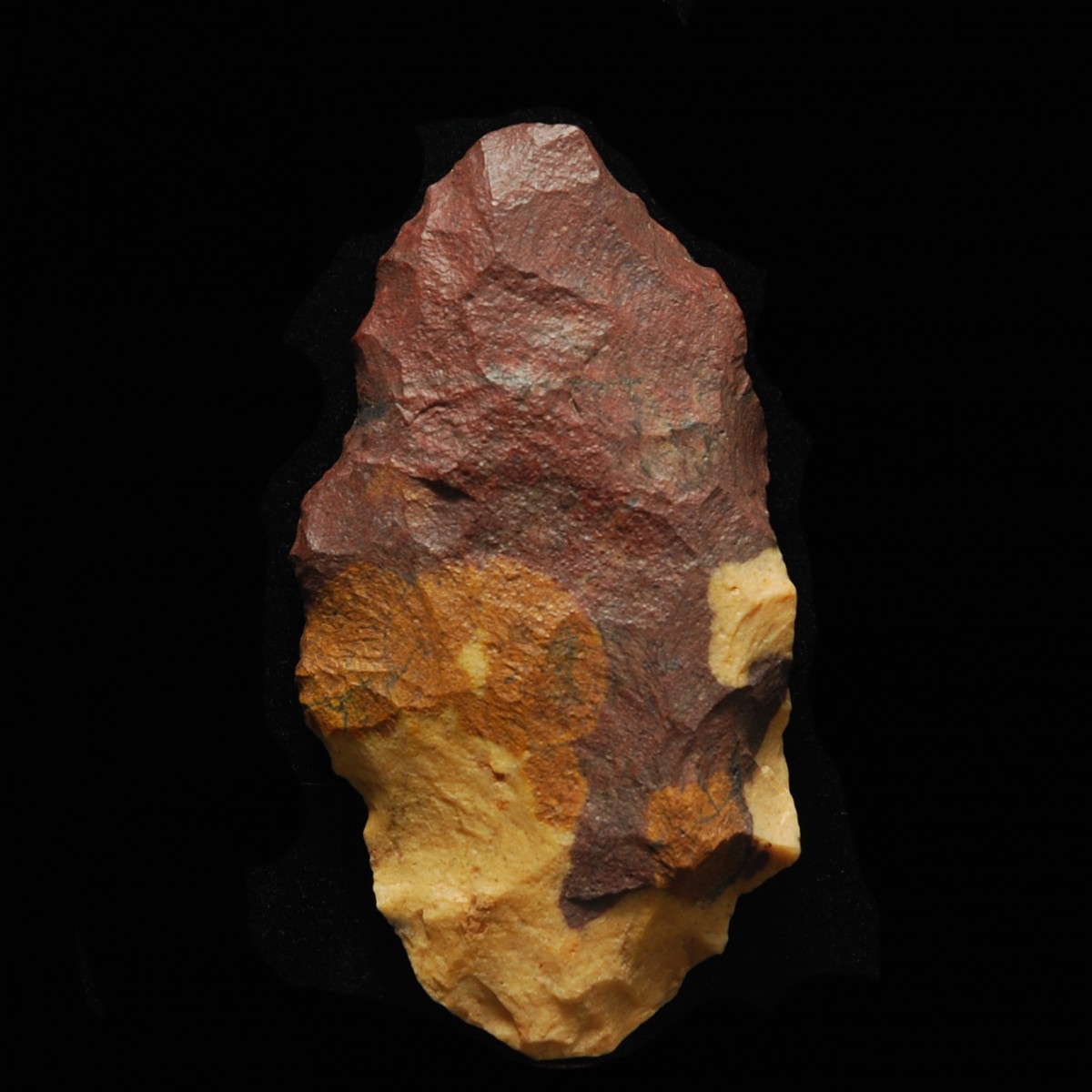
|
|
North Africa/Libya – 400,000-50,000 B.C.
|
|
A very flat and small hand axe of red-brown flintstone worked out on both sides. The edges are sharpened on all sides to cut plants and meat. The tapering end was used as a drill. Wonderful texture. Found in Libya.
|
Dimensions: 8.1 cm x 4.4 cm
Price: 150 Euro
|
|
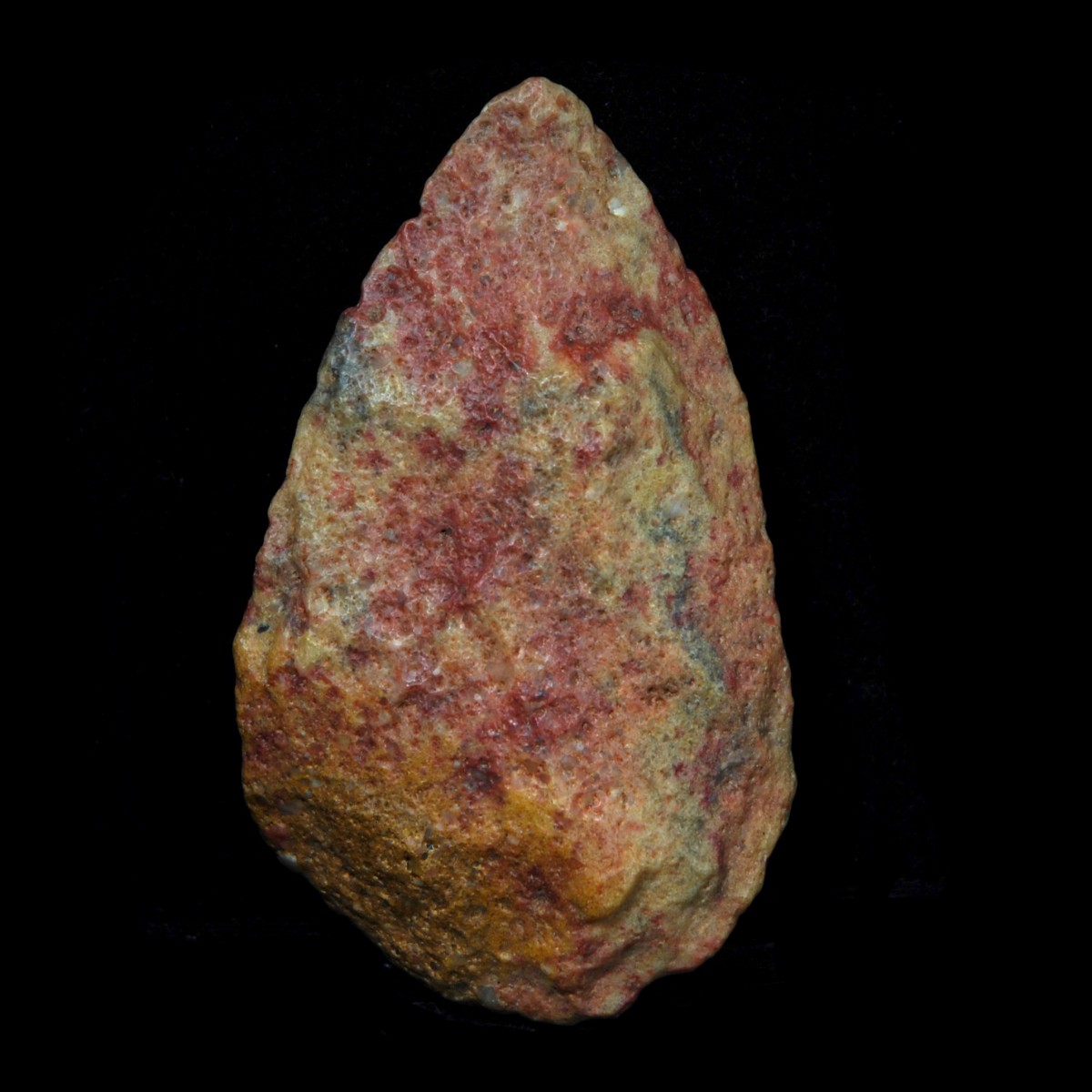
|
|
North Africa/Libya – 400,000-50,000 B.C.
|
|
Hand axe of richly colored quartzite worked out on both sides. The edges are all sharpened to cut plants or meat. The tapering end was used as a drill. With beautiful patina of usage. Found in Libya.
|
Dimensions: 9.5 cm x 5.8 cm
Price: 150 Euro
|
|
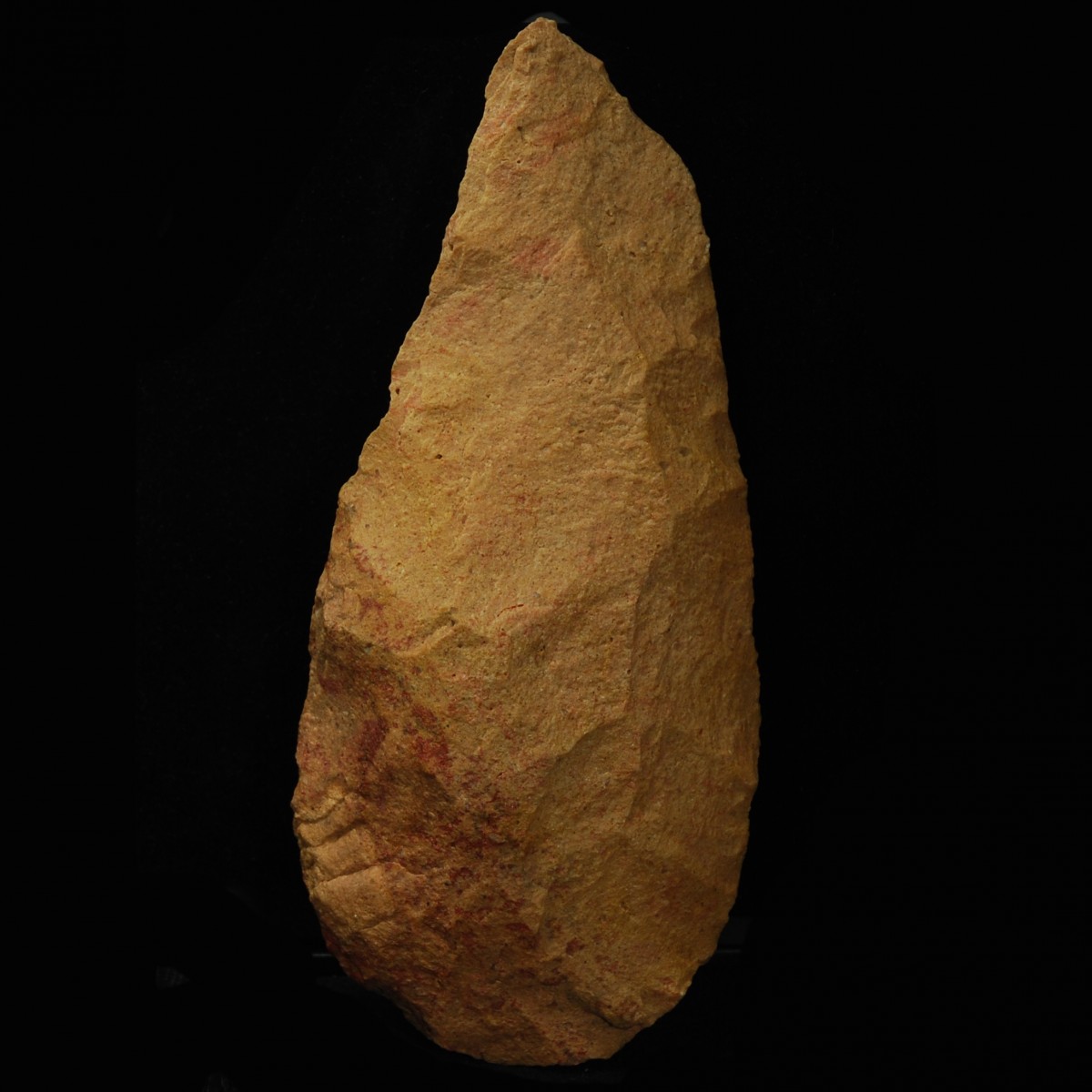
|
|
North Africa/Libya – 800,000-300,000 B.C.
|
|
Large hand axe of light quartzite worked out on both sides with a pointy and a rounded, broad end. The edges are all sharpened to cut plants or meat. The tapering end was used as a drill. Found in Libya.
|
Dimensions: 19.3 cm x 9 cm
Price: 180 Euro
|
|
|
|
|
|
"The Work which is to be Done" – die
große Sommerausstellung
|
Liebe Freunde antiker Kunst, die gute Nachricht gleich vorweg: Unsere zwei Galerien in Wien sind ab sofort wieder wie gewohnt geöffnet. Besuchen Sie uns in unserem Showroom und freuen Sie sich auf zahlreiche neu erworbene antike Kunstwerke, darunter bedeutende Marmorskulpturen wie das Porträt der Kaiserin Agrippina Minor, ägyptische Kostbarkeiten wie das Fayence-Uschebti des Tjanehebu sowie einen nahezu perfekt erhaltenen makedonischen Kavalleriehelm. Antiken in allen Preislagen warten auf Sie und werden Sie bestimmt begeistern. Das kleine Geschäft am Stubenring haben wir neu renoviert und zu einem kleinen Schmuckkästchen umgebaut. Ich freue mich, Sie auch hier auf ein Glas Wein begrüßen zu dürfen.
|
Die große Sommer-Ausstellung ab 9. Juni. Und natürlich haben wir auch in den nächsten Wochen einiges vor: Ab 9. Juni präsentieren wir in unserem Showroom gemeinsam mit dem österreichischen Künstler und Preisträger des STRABAG Artaward Philip Patkotwitsch die Ausstellung "the work that has to be done". Ausgehend von unserer umfangreichen Sammlung von Fayence-Uschebtis hat der Künstler jede einzelne der 230 Figuren in einer Tusche Zeichnung umgesetzt. Diese bewegen sich im Spannungsfeld zwischen Gegenständlichem und Abstrakten, zwischen Archäologie-Zeichnungen und dem freien Spiel mit Licht und Schatten. Wie das aussieht, sehen Sie hier. Der Besuch ist jederzeit zu den Öffnungszeiten oder auf Anfrage möglich.
|
|
|
|
Unser Highlight des Monats:
|
|
Römisches Reich – 1. Jahrhundert n. Chr.
|
Lebensgroßes Porträt der Kaiserin Agrippina Minor, der Frau des Claudius und Mutter des Nero. Das Gesicht mit geraden, feinen Zügen, einer dünnen langen Nase und Augen, die sanft und würdevoll aus dicken Lidern hervorschauen. Der Mund wohl geformt und geschlossen. Die Haare sind in der Mitte gescheitelt, am Kopf wellig und seitlich in dichten kleinen Löckchen auslaufend, die das Gesicht einrahmen. Diese auffällige Haartracht hat Agrippina Minor, die auch Urenkelin des Augustus war, von ihrer Mutter Agrippina Maior übernommen. Sie spielt damit auf ihre vornehme Abstammung aus iulischem Geschlecht an. Der Kopf ist leicht nach links geneigt, weshalb sich die Venusringe auf der linken Seite des dünnen Halses stauen. Der etwas grobkörnige Marmor sowie die geschlossene, nur wenig bewegte Form weisen auf eine Herstellung im östlichen Mittelmeerraum hin. Je weiter das Zentrum Rom entfernt ist, umso mehr tritt Agrippina Minor als zweite Agrippina Maior auf. Dahinter verbirgt sich die große Beliebtheit der Eltern Germanicus und Agrippina Maior. Der Kopf ist mehrfach publiziert: H. Jucker und D. Willers, „Gesichter: Griechische und römische Bildnesse aus Schweizer Besitz“, Bern 1982, Seite 96-97, Nummer 38. Ines Jucker, „Skulpturen der Antiken-Sammlung Ennetwies“, Mainz am Rhein 1995, Band I, Seite 37-38, Nummer 20. In dieser Publikation geht Ines Jucker davon aus, dass es sich nicht um Agrippina Minor, sondern um ein an die Kaiserin angelehntes Privatporträt handelt. Arachne Database Nummer 1082668.
|
Provenienz: Privatsammlung Dr. Anton Pestalozzi (1915-2007), erworben 1977 bei La Reine Margot in Paris. Ausgestellt in: Bernisches Historisches Museum, „Gesichter: Griechische und römische Bildnisse aus Schweizer Besitz“, vom 6. November 1982 bis 6. Februar 1983.
Höhe: 28 cm
Preis: 68.000 Euro
|
|
|
|
Ausgewählte Kunstwerke des Monats:
|
|
Griechenland/Myrina – 2. Jahrhundert v. Chr.
|
Prachtvolle Terrakotta-Statuette der Aphrodite, die auf einer rechteckigen Plinthe steht. Die Göttin trägt ihr Gewicht mit dem rechten Bein und ist entspannt an eine Säule gelehnt. Das linke Bein hat sie schwungvoll vorne um das Standbein geschlagen. Aphrodite ist unbekleidet, sie hält mit der abgestützten linken Hand einen Umhang, der hinten über die Hüfte und faltenreich zwischen den Beinen nach unten fällt. Der rechte Arm ist auf das keck nach außen gedrehte Becken gestützt. Am Kopf trägt sie ein florales Diadem, das Haar ist hinten zu einem runden Knoten gebunden. Mit reichen Farbresten. Wohl aus Myrina. Mit altem Sammlungsetikett auf der Unterseite.
|
Provenienz: Französische Privatsammlung Charles-Louis Frossard (1827-1902). Durch Erbe an die Tochter Emilie Isabelle Frossard (1854-1921). Durch Erbe an Henry Schloesing (1879-1958). Von diesem 1928 verkauft an Joseph Altounian (1890-1954). Seitdem in Familienbesitz. Mit der Kopie einer alten Sammlungsfotografie aus dem Hause Frossard und einem französischen Antikenpass.
Höhe: 27,7 cm
Preis: 6.800 Euro
|
|
|
|
|
Iran/Luristan – Ende 2. Jahrtausend v. Chr.
|
Massives und sehr langes Bronzeschwert, das aus zwei Teilen gearbeitet ist. Der Griff mit vierkantigem Querschnitt läuft in einer Gabel aus, die die Klinge überfängt. Der sattelförmige, hohle Knauf an den Seiten mit schräg nach außen verlaufenden Fächern versehen, die dem Schwert ihren Namen geben. Die spitz zulaufende Klinge mit gewölbtem Mittelgrat.
|
Provenienz: Alte belgische Privatsammlung. Danach bei André Munter Archeologie, Brüssel. Dort erworben am 11. März 2002 von einer anderen belgischen Privatsammlung. Mit Original-Zertifikat von André De Munter, Brüssel. Auf der Rückseite des Zertifikats ein Aufkleber mit Stempel einer Gerichtsbeschau vom 26. Juni 2009 mit der Unterschrift des Gerichtsschreibers F. Coene N.
Länge: 69 cm
Preis: 4.000 Euro
|
|
|
|
|
Griechenland – um 550 v. Chr.
|
Ausdrucksstarke Terrakotta-Büste einer Göttin aus archaischer Zeit. Das hohl gearbeitete Statuenfragment mit ovalem Gesicht, dem typischen Lächeln und mandelförmigen Augen. Die Göttin trägt einen hohen Polos, unter dem kurze Locken hervorschauen, die das Gesicht einrahmen. Zwei lange Haarsträhnen fallen ihr seitlich über die Schultern und reichen bis in Brusthöhe. Die Ohren sind mit großen, scheibenförmigen Ohrringen geschmückt. Gesicht und Körper sind aus der Form gepresst, einzelne Details wie Haarsträhnen und Ohrschmuck per Hand geformt. Gesockelt.
|
Provenienz: Schweizer Privatsammlung Zakos, 1980er Jahre. Danach in einer US-Sammlung in New York.
Höhe: 19,5 cm
Preis: 4.800 Euro
|
|
|
|
|
Ägypten – 26. Dynastie, Regierungszeit des Amasis II., 570-526 v. Chr.
|
Uschebti aus grün glasierter Fayence, das aus dem Grab des Tjanehebu stammt. Die mumienförmige Gestalt mit dreiteiliger Perücke, falschem Bart, Rückenpfeiler und vor der Brust gekreuzten Armen. Das Uschebti hält Hacke und Handpflug, über der linken Schulter hängt das Samensäckchen. Die elfzeilige Inschrift nennt als Besitzer Tjanehebu, den Aufseher der königlichen Schiffe, Sohn der Taneferetiyti. Die Übersetzung lautet: „Der Erleuchtete, Osiris, der Aufseher der königlichen Schiffe, Tjanehebu, geboren von Taneferetiyti, er spricht: Oh, diese Uschebtis, wenn jemand aufruft den Osiris, den Aufseher der königlichen Schiffe, Tjanehebu, gerechtfertigt, Arbeit zu leisten, die dort im Totenreich geleistet wird – wenn nämlich ein Mann dort zu seiner (Arbeits)leistung verurteilt wird –, dann verpflichte du dich (zu) dem, was dort getan wird, um die Felder zu bestellen und die Ufer zu bewässern, um den Sand (Dünger) des Ostens und des Westens überzufahren. ‚Ich will es tun. Hier bin ich‘ sollst du sagen.“ Das Grab des Tjanehebu wurde vom italienischen Ägyptologen Alessandro Barsanti im Jahr 1900 südlich der Pyramide des Unas in Sakkara gefunden. Die gefundenen Uschebtis wurden in alle Welt verkauft – vergleiche etwa das Exemplar im British Museum mit der Registration Number 1901,0311.16. Gesockelt.
|
Provenienz: Deutsche Privatsammlung seit 1970.
Höhe: 18,6 cm
Preis: 6.800 Euro
|
|
|
|
|
Römisches Reich – 2.-3. Jahrhundert n. Chr.
|
Sofort tragbare Goldkette mit verschieden großen, blauen Glasperlen. Den Abschluss bilden große Glasperlen mit fein geschliffenen Rändern. Vier Perlen sind aus blauem und weißem Glas. Die Kettenglieder aus Golddraht sind wohl aus dem frühen 20. Jahrhundert.
|
Provenienz: Deutsche Privatsammlung H.-D. D., Nordrhein-Westfalen. Erworben zwischen 1975 und 1998.
Länge: 58 cm
Preis: 1.600 Euro
|
|
|
|
|
Römisches Reich/Gallien – 2. Jahrhundert n. Chr.
|
Große Bronze-Applike in Form einer Herme mit dem Kopf des Merkur (Hermes). Das Gesicht von dichten Locken gerahmt, auf denen die Flügel des Gottes aufsitzen. Der Oberkörper in einen feine Falten werfenden Umhang gewickelt, den der Gott an die Brust drückt. Der Pfeilerschaft in der Mitte mit dem üblichen Phallus, der aus einem erhabenen Band hervorsteht. Am unteren Ende der Säule eine kreisrunde Basis, in die Zehen eingekerbt wurden. Seltene, sehr feine Darstellung einer Bronze-Herme, die wohl einst ein Möbel zierte. Auf altem Holzsockel.
|
Provenienz: Alte Französische Privatsammlung.
Höhe: 20,5 cm
Preis: 3.800 Euro
|
|
|
|
|
Ägypten – 3. Zwischenzeit, 1070-664 v. Chr.
|
Hochwertig gearbeitetes Fayence-Amulett des schlangenköpfigen Gottes Nehebkau, der als Wächter über den Eingang ins Jenseits und einer der 42 Totenrichter gilt. Nehebkau ist sitzend dargestellt, seine Arme unter den großen Schlangenkopf gelegt. Am Hinterkopf eine Öse zur Aufhängung. Gesockelt.
|
Provenienz: Französische Privatsammlung Bourgade-Maturana, erworben am 7. Juni 1977 bei Laurin Guilloux Buffetaud Tailleur in Paris. Mit Kopie der Original-Rechnung und französischem Antikenpass.
Höhe: 3,8 cm
Preis: 1.600 Euro
|
|
|
|
|
Römisches Reich – 2. Jahrhundert n. Chr.
|
Römischer Goldring mit einer Schiene aus Goldblech, die sich zur Ringplatte hin verbreitert. Die Fassung, ebenfalls aus Goldblech, hält einen längsovalen, mehrlagigen dreifarbigen Achat. Sofort tragbar.
|
Provenienz: Sammlung Maurice Bovier (1901-1981), Schweiz.
Dimensionen: Höhe 2,1 cm; Ringdurchmesser 2,1 cm; Gewicht 2,7 Gramm
Preis: 600 Euro
|
|
|
|
|
Griechenland/Böotien – 6. Jahrhundert v. Chr.
|
Handgeformte Terrakotta-Statuette eines Pferdes. Der Körper schlank mit vier geraden Beinen. Der Schwanz lang und leicht abstehend, der Kopf mit aufgestellten Ohren zur Seite gewandt. Die Augen durch runde Ausbuchtungen angegeben.
|
Provenienz: Charles Ede London 1978, danach Sammlung Dr. Anton Pestalozzi (1915-2007), Zürich.
Höhe: 12,8 cm
Preis: 600 Euro
|
|
|
|
|
Mitteleuropa – 11.-10. Jahrhundert v. Chr.
|
Lang gezogene Spiralröhre, die aus einem massiven Bronzedraht mit erhöhtem Mittelgrat besteht. An den beiden Enden der Röhre jeweils eine fein gedrehte Endspirale. Spiralröhren wie diese waren Teil der mitteleuropäischen Ritualtracht in der Urnenfelderzeit. Gesockelt.
|
Provenienz: Sammlung Hagenauer, Wien.
Länge: 16,4 cm
Preis: 380 Euro
|
|
|
|
Eine Sammlung steinzeitlicher Faustkeile aus dem Nachlass von Wilfriede und Leopold Tamm, Langenzersdorf, Österreich.
Erworben in den 1970er Jahren:
|
|
|
|
Nordafrika/Libyen – 400.000 – 50.000 v. Chr.
|
|
Beidseitig gearbeitetes, kleines Steinwerkzeug mit scharfkantigen Rippen auf der Seite, um damit Pflanzen zu schneiden oder Fleisch zu zerteilen. Herrliche Maserung. Gefunden in Libyen.
|
Dimensionen: 7 cm x 4,8 cm
Preis: 200 Euro
|
|
|
Nordafrika/Libyen – 800.000 – 300.000 v. Chr.
|
Beidseitig gearbeiteter, massiver und schwerer Faustkeil aus hellem Quarzit. Die Kanten sind umlaufend geschärft, um damit Pflanzen zu schneiden oder Fleisch zu zerteilen. Das spitz zulaufende Ende wurde als Bohrer verwendet. Mit schöner Wüstenpatina. Gefunden in Libyen.
|
Dimensionen: 15,5 cm x 9,5 cm
Preis: 200 Euro
|
|
|
Nordafrika/Libyen – 400.000 – 50.000 v. Chr.
|
Beidseitig gearbeiteter, sehr flacher und kleiner Faustkeil aus rötlich-braunem Feuerstein. Die Kanten sind umlaufend geschärft, um damit Pflanzen zu schneiden oder Fleisch zu zerteilen. Das spitz zulaufende Ende wurde als Bohrer verwendet. Herrliche Maserung. Gefunden in Libyen.
|
Dimensionen: 8,1 cm x 4,4 cm
Preis: 150 Euro
|
|
|
Nordafrika/Libyen – 800.000 – 300.000 v. Chr.
|
Beidseitig gearbeiteter Faustkeil aus farblich reich durchzogenem Quarzit. Die Kanten sind umlaufend geschärft, um damit Pflanzen zu schneiden oder Fleisch zu zerteilen. Das spitz zulaufende Ende wurde als Bohrer verwendet. Mit schöner Gebrauchspatina. Gefunden in Libyen.
|
Dimensionen: 9,5 cm x 5,8 cm
Preis: 150 Euro
|
|
|
Nordafrika/Libyen – 800.000 – 300.000 v. Chr.
|
Beidseitig gearbeiteter, großer Faustkeil aus hellem Quarzit mit einem spitzen und einem abgerundeten, breitem Ende. Die Kanten sind umlaufend geschärft, um damit Pflanzen zu schneiden oder Fleisch zu zerteilen. Das spitz zulaufende Ende wurde als Bohrer verwendet. Gefunden in Libyen.
|
Dimensionen: 19,3 cm x 9 cm
Preis: 180 Euro
|
|
|
|
|
|
|
|
|
|
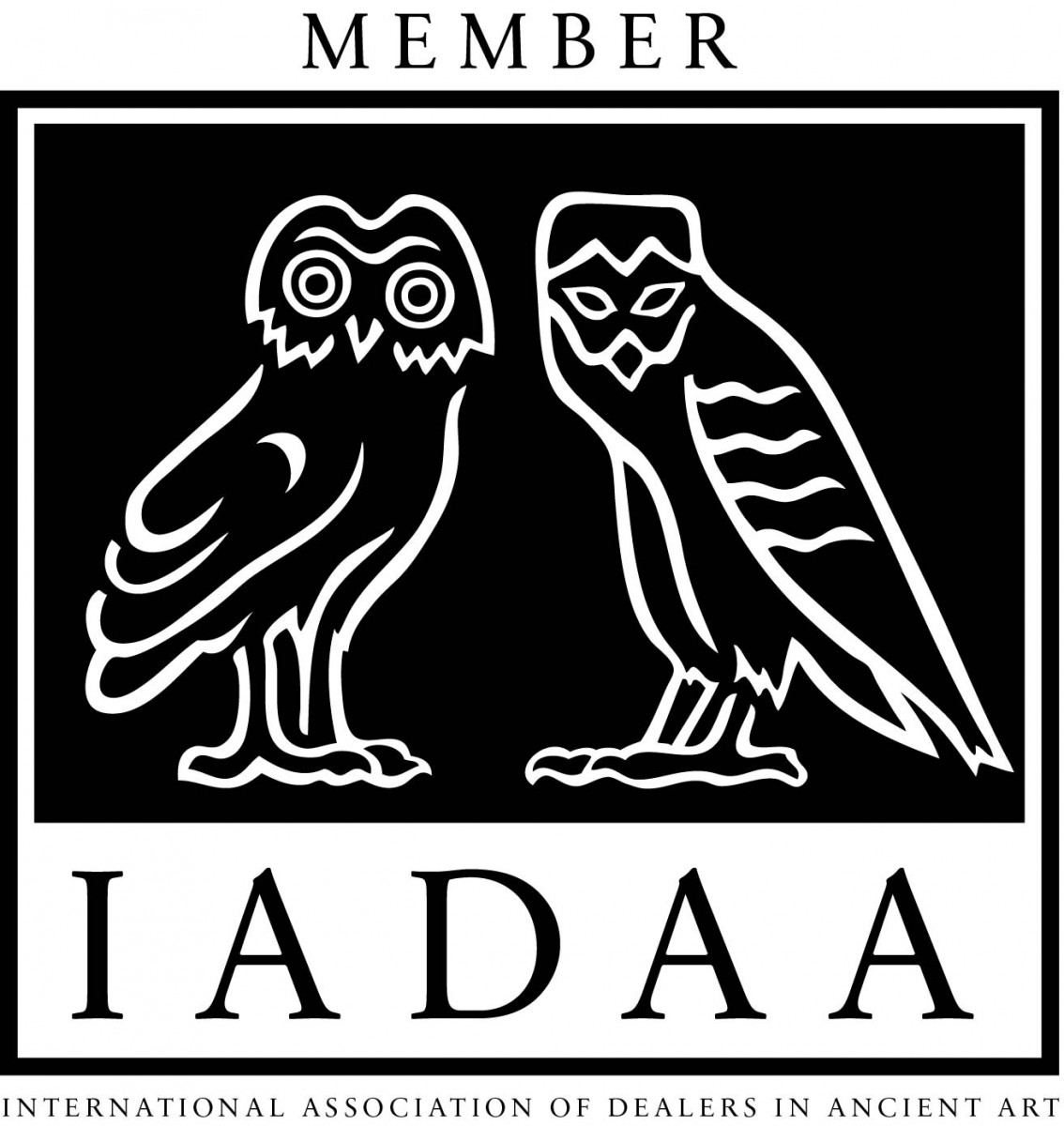
|
|
|
|